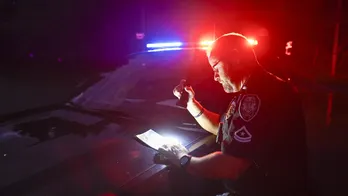Exclusive glimpse of Antarctica: 'Expect the unexpected when cruising' this harsh, cold and beautiful place
It’s the world’s largest desert — and the highest, the windiest and the least populated continent.
Expect the unexpected when cruising Antarctica.
To be sure, it will be quite different from your favorite beach destination.
POLAR BEAR IS SNAPPED STANDING UPRIGHT IN CANADA'S BAFFIN ISLAND: ‘GAVE ME GOOSEBUMPS’
Cold, harsh, and breathtakingly beautiful, it offers an amazing glimpse at the life of penguins who appear to be stuck in the Ice Age.
So, what is it like going there?
This writer traveled there recently — and is privileged to share observations and insights.
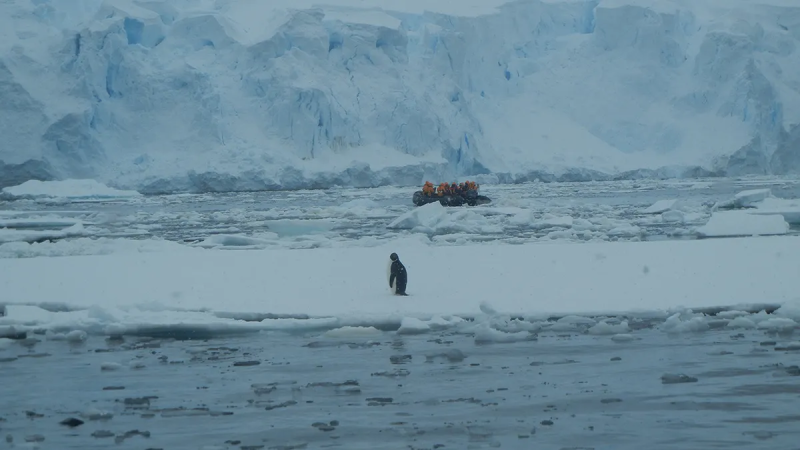
"The captain told us to put away all freestanding belongings in our cabins in preparation for rough waters." (Danuta Hamlin/Fox News)
‘ANTARCTICA: THE BEAUTY AND THE BEAST’
I have no fear . . . I have no dread.
Of that marked day that lies ahead.
My flesh will turn to ash and clay ...
The captain recited a morbid poem over the loudspeaker — then told us to put away all freestanding belongings in our cabins in preparation for rough waters.
We had been at sea for a few days already.
Our journey began in Buenos Aires, Argentina, which allowed us to enjoy warm weather and the lovely port of Montevideo, Uruguay.
TO RAISE MILLIONS FOR CANCER CHARITIES, ONE CEO WILL TREK ACROSS THE SOUTH POLE: ‘A RISK WORTH TAKING’
But by the time we reached the Falkland Islands the wind picked up, and the tide grew too high to use the little tender boats to visit Port Stanley.
The captain decided to bypass the Falklands altogether and sailed the ship straight into the notorious Drake Passage.
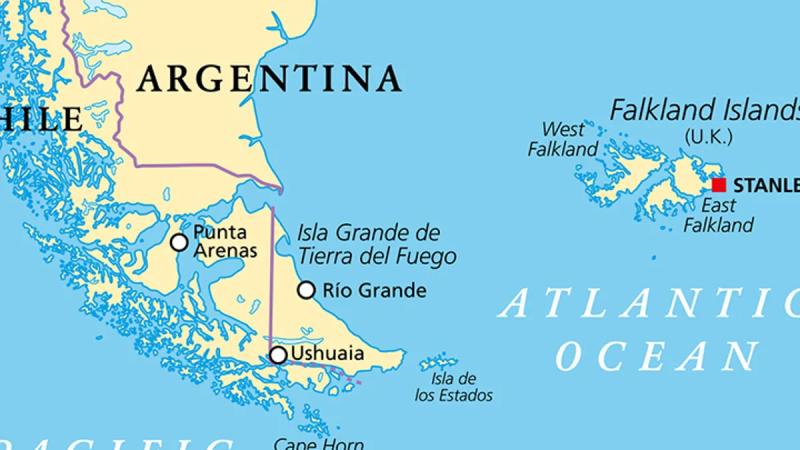
Drake Passage, political map. Mar de Hoces, Hoces Sea, the body of water between Cape Horn and Antarctica Peninsula. Connects South Atlantic Ocean with South Pacific Ocean, extends into Southern Ocean. (iStock)
It was a calm evening, however, so we went to bed convinced that the Norwegian Captain ever so slightly exaggerated the menace of the Drake.
The passage, named after 16th century English explorer Sir Francis Drake, is considered one of the most treacherous voyages for ships to make.
It's a turbulent body of water between Cape Horn and the South Shetland Islands, where the Pacific and Atlantic oceans collide with unforgiving force.
ANTARCTIC ICE LOSS LIKELY WIPES OUT 4 COLONIES' WORTH OF EMPEROR PENGUIN CHICKS, RESEARCHERS SAY
We discovered what it all really meant around 2 a.m. when a glass filled with water flew off the nightstand in our stateroom.
Books and cell phones followed, crashing to the floor.
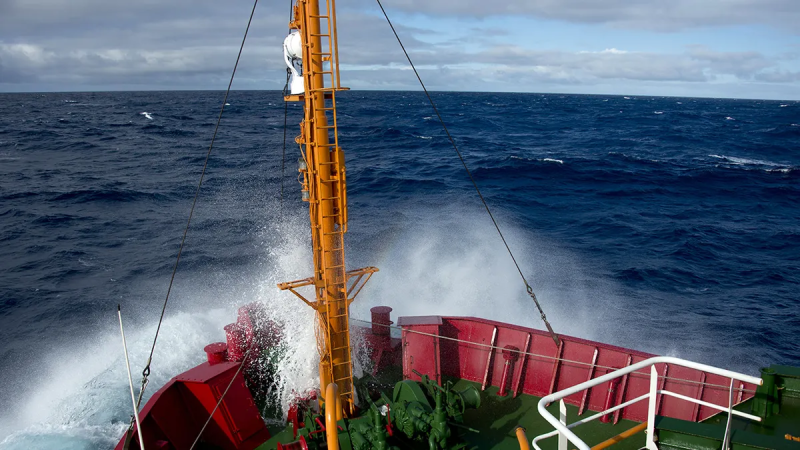
The Brazilian Navy's Oceanographic Ship Ary Rongel is showing going through the Drake Passage on its way to Antarctica on March 3, 2014. (VANDERLEI ALMEIDA/AFP via Getty Images)
I jumped out of bed to put things in order just to find the ship swaying like crazy and all my organs seeming to shift inside my body in all sorts of directions.
To be on the safe side, we popped anti-nausea pills — which tend to work well when taken before one becomes seasick — and crawled back into bed.
With short intervals to fetch food and take more pills, we remained put and watched movies.
Twenty-four hours later, the coast was clear ... and we could feel the chilly air and the excitement of approaching the Antarctic Peninsula.
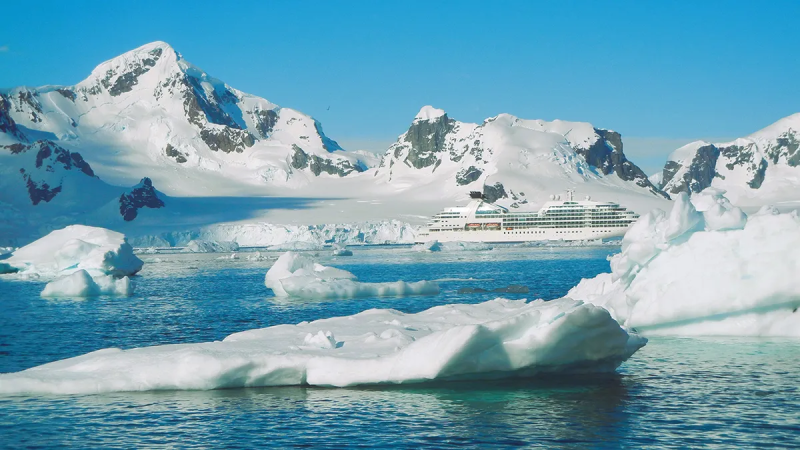
The MV Seabourn Quest is pictured loitering in Antarctica. (Danuta Hamlin/Fox News)
We were sailing aboard Seabourn Quest, a vessel reinforced for the Antarctic ice and adventures.
ICEBERG LARGER THAN LONDON BREAKS OFF ANTARCTICA ICE SHELF
Since it was an expedition cruise, we were divided into exploration groups.
We had to attend daily lectures to familiarize ourselves with rules, regulations and all kinds of amazing things related to the seventh continent.
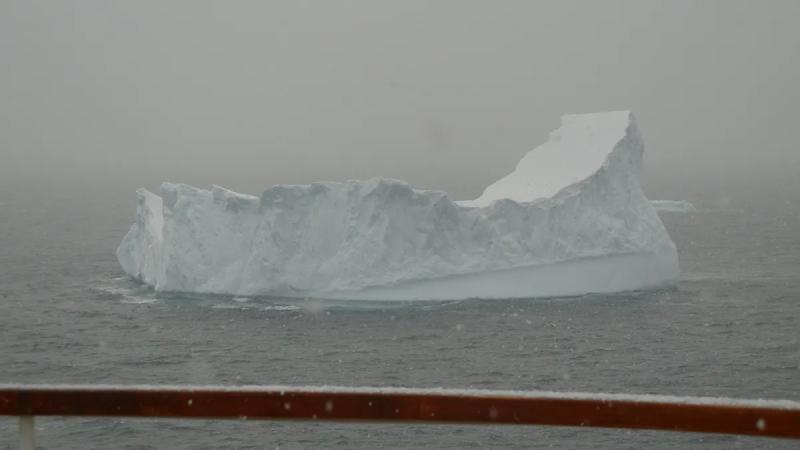
An Antarctic iceberg is seen floating in the Southern Ocean. (Danuta Hamlin/Fox News)
We were still some distance away when during one such lecture we heard a booming voice: "Iceberg on the port side."
Now, who in their right mind would not want to see the first iceberg?
We all jumped to our feet and hurried in the direction indicated by the captain.
The iceberg turned out to be quite small, nothing to write home about — but the captain blasted out again, telling us that we could not all congregate on just one side of the ship.
We didn’t want the vessel to tip over, so everyone dispersed.
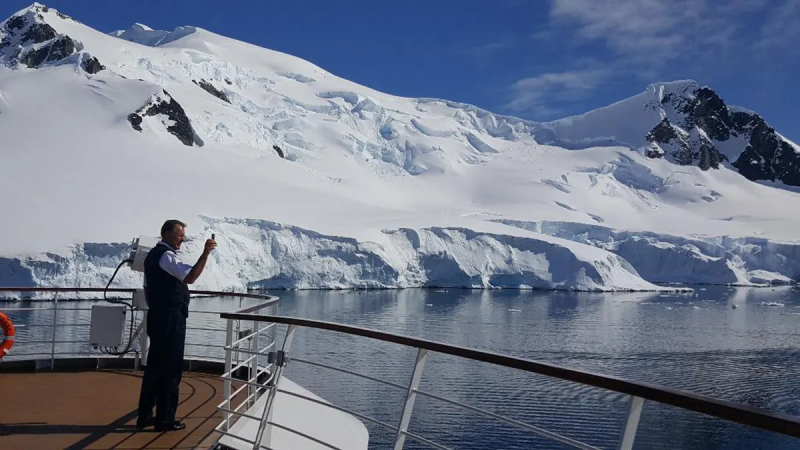
Norwegian Captain Dag is pictured making his own memories of Antarctica. (Danuta Hamlin/Fox News)
Soon enough, we were facing the majestic Antarctica.
MASSIVE WAVES BOMBARD DRAKE PASSAGE CRUISE SHIPS IN VIRAL VIDEOS: WHAT TO KNOW ABOUT ANTARCTICA CRUISES
We were all in awe of its incredible beauty: the whiteness of the snow, the turquoise-colored ice, the seals basking in the summer sun, the pristine, clear air, the unapproachable, hostile cliffs, the absolute silence … and the penguins traveling on icebergs.
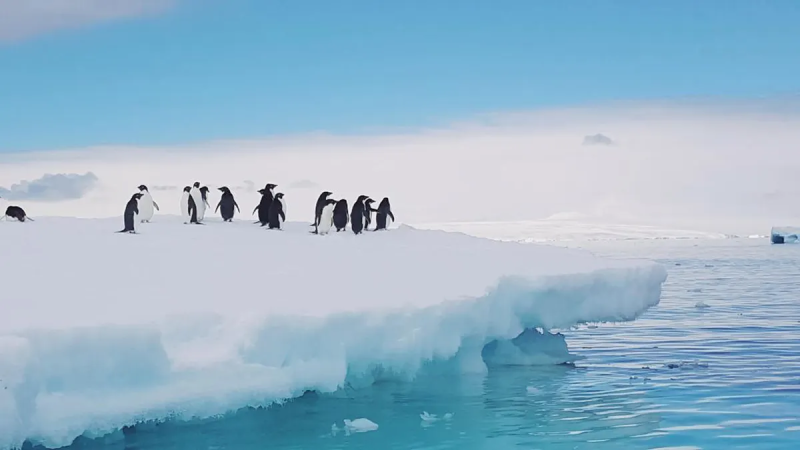
Adelie penguins are shown traveling on an iceberg in Antarctica. (Danuta Hamlin/Fox News)
There are no ports in the Antarctic Peninsula — zodiac pontoon boats take tourists to the land, and everyone disembarks either directly onto ice or into the water.
Long rubber boots are issued to passengers, and drinking coffee before disembarkation is not recommended.
The attraction is the frozen land and its residents — mainly the penguins.
There are no restrooms available, no real commerce ... just some old bases for explorers turned into museums, and an Argentinian settlement called Esperanza Base.
The attraction is the frozen land and its residents — mainly the penguins.
During our expedition we encountered three different species: Chinstraps, Adelines and Gentoos.
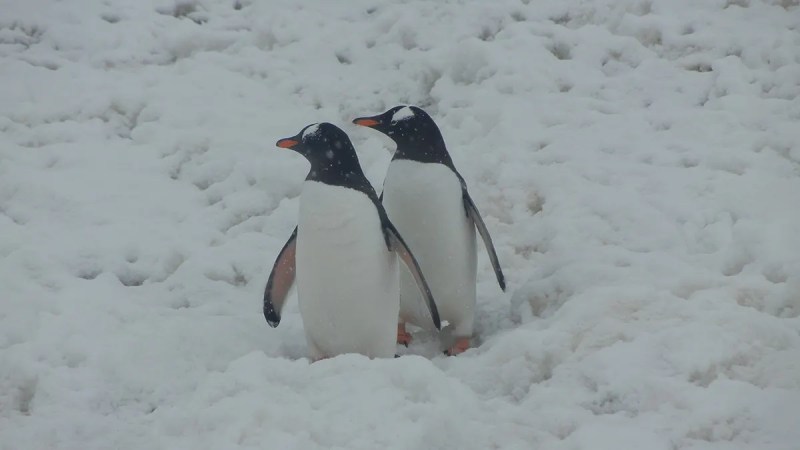
Gentoo penguins are pictured up close in Antarctica. (Danuta Hamlin/Fox News)
The penguins appeared to be at ease with visitors, going about their daily business, hardly paying any attention to humans.
The expert expedition crew members made sure everyone’s boots were disinfected, and no bacteria made its way from the ship to the land.
We even had our clothes inspected.
Any feeding of wildlife is strictly prohibited in Antarctica — and only small numbers of people are allowed on shore at one time.
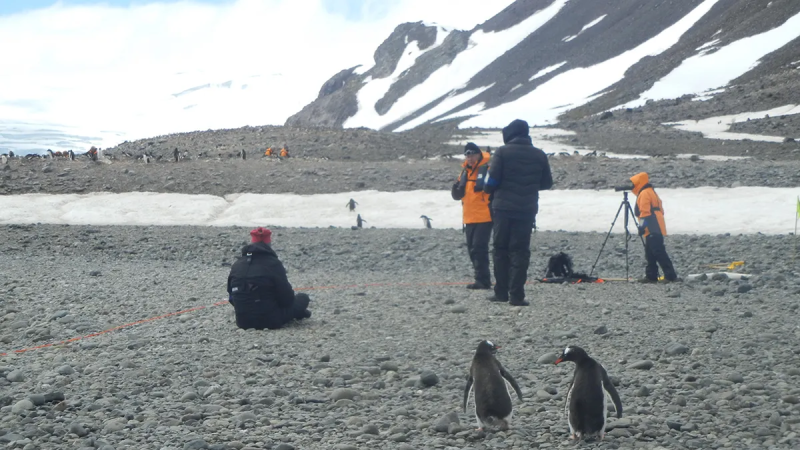
Gentoo penguins are shown walking toward tourists in Antartica. (Danuta Hamlin/Fox News)
Penguins are everywhere, and they are fascinating. They are birds that do not fly but are expert swimmers.
The Antarctic Ocean is the source of their food supply, but also their biggest adversary ... not because of the low temperature of the water but because of the ever-present leopard seal predators.
Penguins gather in groups and dive in large numbers to diminish the odds of being eaten.

Group of Adelie penguins take the plunge into the water together. (Danuta Hamlin/Fox News)
Oddly enough, they have very short legs, even though they live in a habitat with snow piling up high around them.
To manage, penguins move along the same paths, known as penguin highways, walking up and down or sliding on their bellies, while gathering pebbles to reinforce their nests.
All tourists are required to stay clear of these highways and not allowed to disrupt penguin habitats.
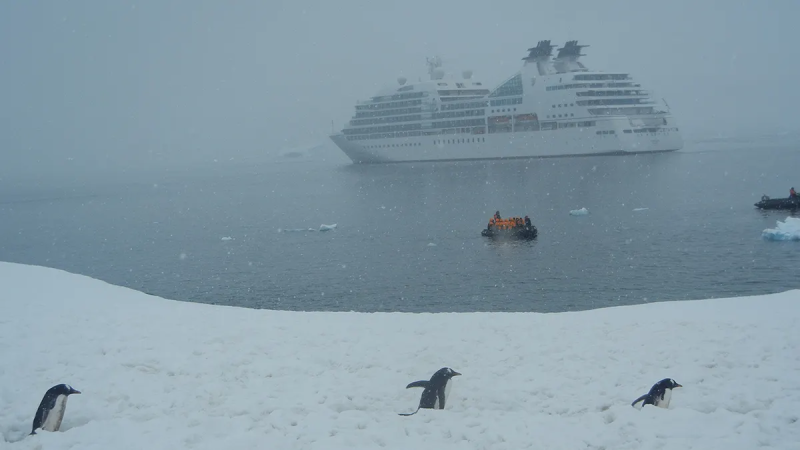
Zodiac boats are shown heading for the frozen land; in the foreground, penguins. (Danuta Hamlin/Fox News)
Antarctica can be quite cold even during the summer, while the winter is incredibly harsh. The life of a penguin can be shockingly difficult.
The one good thing about their habitat is the absence of polar bears, which are found only in the Arctic on the other side of the globe.
ANTARCTICA'S ‘DOOMSDAY GLACIER’ IS MELTING AWAY DIFFERENTLY THAN SCIENTISTS FIRST THOUGHT
I asked one of our expedition guides why the similar Arctic climate in the north wasn’t home to any penguins.
He replied that efforts had been made in the past to resettle penguins to the Arctic, but it did not end well for them, as they wound up being eaten by the polar bears.
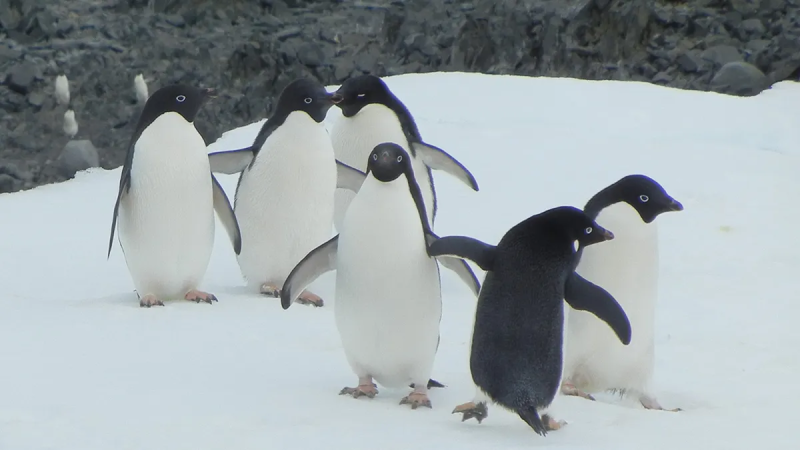
A group of Adelie penguins are shown congregating. (Danuta Hamlin/Fox News)
Although the penguins are almost too adorable for one to stop observing them, one cannot forget about the seals and the whales.
Poached almost to extinction in the past, they thrive now and entertain tourists with their fancy dives and waterspouts.

A sea lion is photographed napping on a pillow of snow. (Danuta Hamlin/Fox News)
Cruising in the Antarctic Peninsula offers some truly breathtaking views — but can be tricky.
The intended destination can change at any time due to ice and weather conditions.
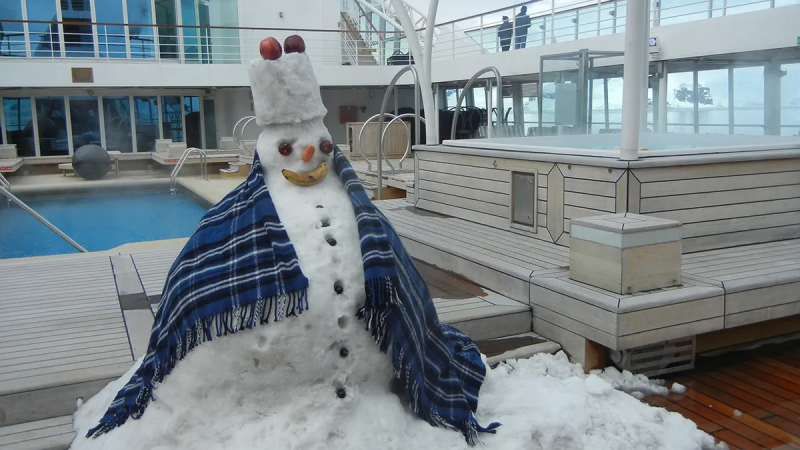
A snowman "travels" aboard the Seabourn Quest. (Danuta Hamlin/Fox News)
One morning, while enjoying a sip of coffee on the deck, I noticed that our ship turned around suddenly and began sailing in the opposite direction.
In a voice bordering on desperation, our cruise director announced that she had no idea whatsoever where we were going — and was giving up on announcing any future landings.
COFFE'S ‘CONTRIBUTION TO CLIMATE CHANGE' IS JUST THE 'TIP OF THE ICEBERG,' STUDY SAYS
Little did we know what our captain had in store for us that day.
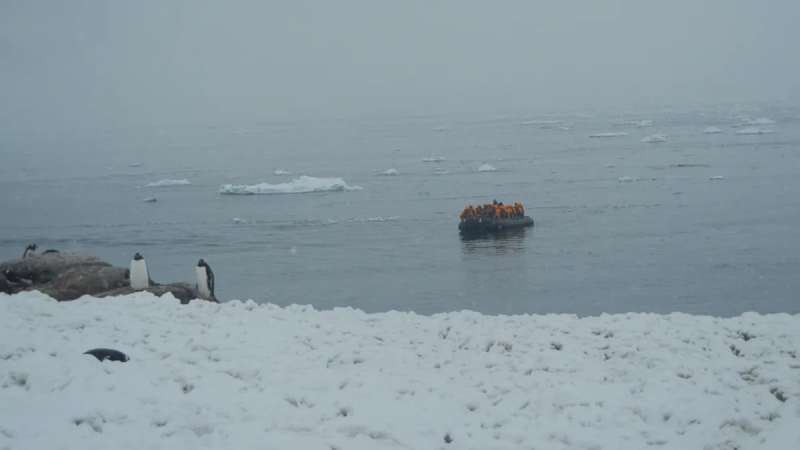
Zodiac heading for the rocks to disembark tourists. (Danuta Hamlin/Fox News)
Snow was falling and ice shields covered the water near our original destination — the old British Antarctic base, which is now a tiny museum.
The captain halted the ship next to a pile of rocks.
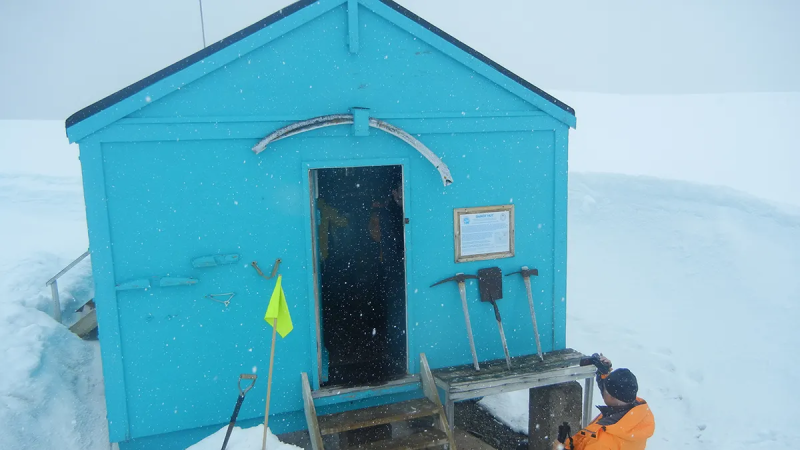
Old British Base in the Antarctic Peninsula, 2016. (Danuta Hamlin/Fox News)
He then informed us that from there, we only had about half an hour walk to the base.
The first explorer group boarded the zodiacs and vanished.
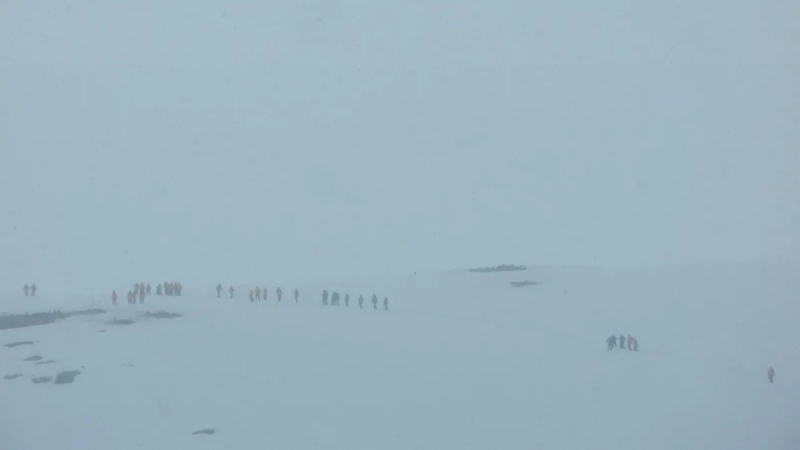
Passengers making their way to the Old British Base on a snowy morning. (Danuta Hamlin/Fox News)
When our turn came, we were told to follow in the footsteps of those who went before us.
Well, following footsteps left in very deep snow turned out to be quite difficult.
If we were in Norway or Alaska, perhaps there would be a rental shop with snowshoes or cross-country skis — but in Antarctica nature rules.
It became obvious that we were sailing into a dense soup of freshly broken ice sheet.
It was the hardest walk of my life, trying to stay on the icy surface, but frequently sinking deep in snow.
We all made our way to the British base and back ... with our clothing soaked through from perspiration.
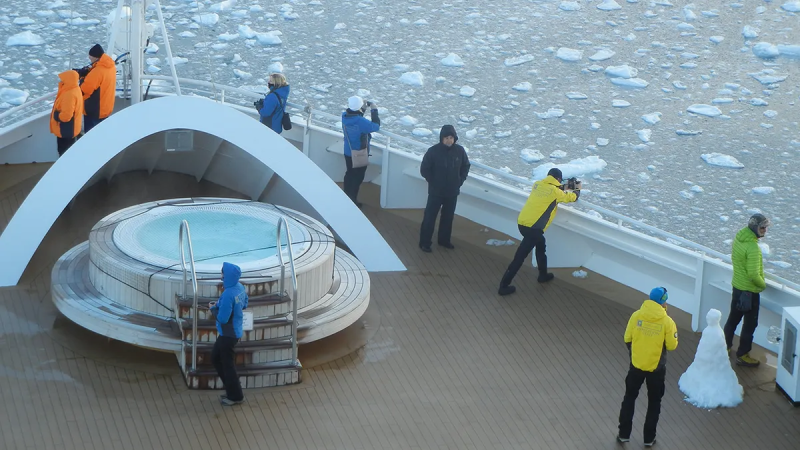
Passengers, bundled up, are pictured enjoying the views on deck. (Danuta Hamlin/Fox News)
Aboard the vessel, we were able to relax and enjoy the spectacular views without much physical effort. We saw small pieces of broken ice begin to appear, with penguins drifting on some, seals resting on others.
It was fun for a while, until it became obvious that we were sailing into a dense soup of freshly broken ice sheet.
CLICK HERE TO SIGN UP FOR OUR LIFESTYLE NEWSLETTER
Passengers began to spill out onto the decks, looking concerned, wondering if there was a chance we could get stuck.
But as they stared ahead, the ice was only getting denser … and this time we did not turn around.

The Seabourn Quest is shown crunching through thick ice. (Danuta Hamlin/Fox News)
Our captain was not a quitter. He crunched through the ice the entire night. We were banging into pieces of ice and the vessel was screeching as if it were on its last leg.
By the morning, we were out of the ice passage.
We asked the captain how often a ship like this actually sinks, but before he could answer one of the passengers piped up, "Usually only once."

The Chilean base on the Antarctic mainland. (Danuta Hamlin/Fox News)
Brilliant sun came out.
And we spent a lovely day at a Chilean base on the mainland, getting our passports stamped and doing some penguin watching.
But the Antarctic excitement wasn’t over yet, as soon enough, we found ourselves sailing through Iceberg Alley.
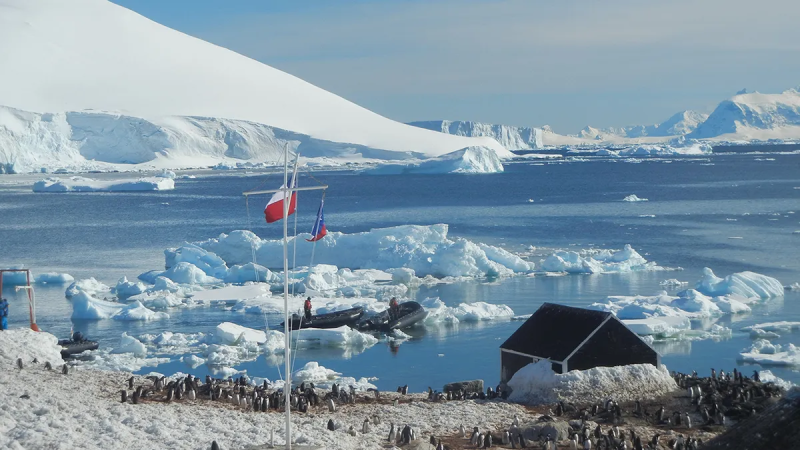
Beautifully situated Chilean base on the Antarctic mainland. (Danuta Hamlin/Fox News)
We had a second captain on board just to navigate the icebergs, so we felt confident that we were in good hands.
It was an incredible, almost eerie, sight — rows of floating iceberg of humongous proportions, as far as the eye could see.
I spotted penguins traveling on one of them, but for the most part they were just empty blocks of ice, drifting aimlessly.
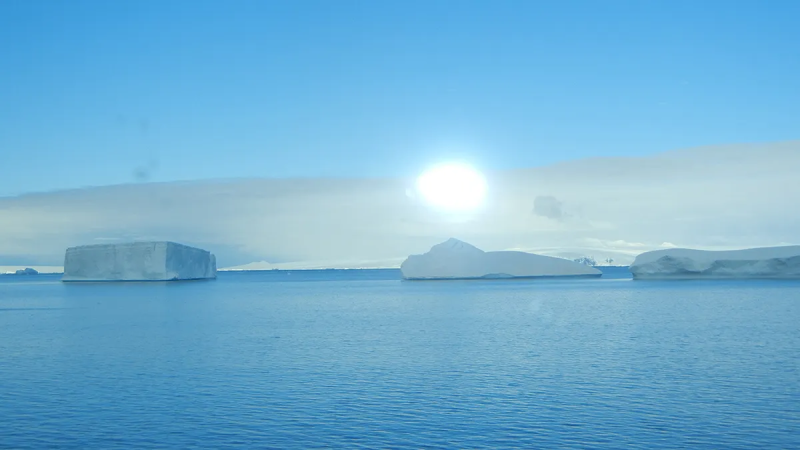
Iceberg Alley in Antarctica. The Antarctic continent holds over 60% of global fresh water supplies, frozen in the icebergs and ice layer on the continent. (Danuta Hamlin/Fox News)
The surprising thing is that icebergs are not made of frozen saltwater. They are freshwater layers of compressed snow and could serve as a good source of drinkable water if defrosted and properly filtered.
The Antarctic continent holds over 60% of global fresh water supplies, frozen in the icebergs and ice layer on the continent.
The overwhelming beauty of the landscape makes visitors want to forget about its dangers.
Some scientists are working on finding a feasible way of turning the floating icebergs into a water supply for the parts of the Southern Hemisphere starved for H2O.
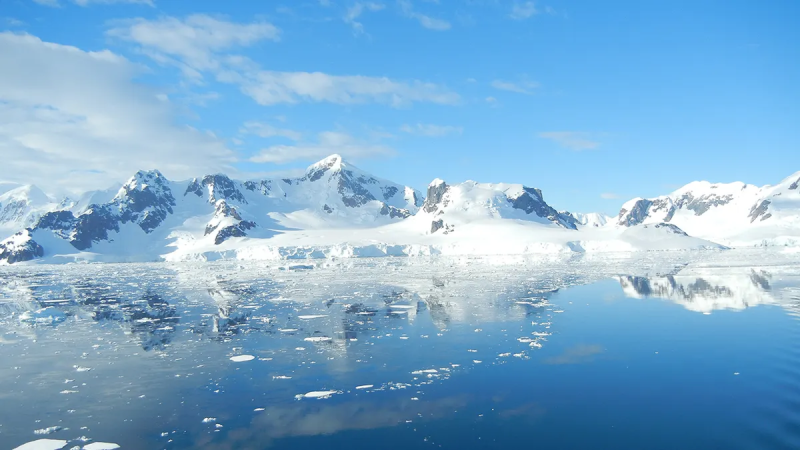
A view of breathtakingly beautiful shores of Antarctica. (Danuta Hamlin/Fox News)
Antarctica is the world’s largest desert — and the coldest, windiest and least colorful continent, veiled in almost absolute silence.
It’s been set aside and protected as a scientific preserve by the Antarctic treaty, now signed by 56 countries.
It’s a very special place where the overwhelming beauty of the landscape makes visitors want to forget about its dangers.
CLICK HERE TO GET THE FOX NEWS APP
But she will not let you do that.
For this traveler, at least, she’s the beauty and the beast — the ultimate adventure back to the ice age.
For more Lifestyle articles, visit www.foxnews/lifestyle
Disclaimer: The copyright of this article belongs to the original author. Reposting this article is solely for the purpose of information dissemination and does not constitute any investment advice. If there is any infringement, please contact us immediately. We will make corrections or deletions as necessary. Thank you.







